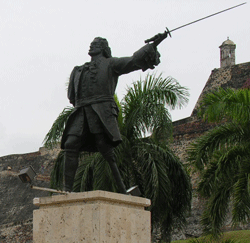History
 We imagine History to be something that is real and factual, something objective and absolute. But the truth is that History turns out to have different currents, different points of view about its "facts". A case in point is the rather different versions of the history of the Caribbean, and with it that of the north coast of what is now Colombia including Cartagena. There is the Spanish version of events, and a very different English version. Each viewpoint reflects the interests of its monarchs and its empire. Amongst those of Spanish descent what passes for history in the English-speaking world, at least insofar as it refers to Spain, is referred to as "The Black Legend".
We imagine History to be something that is real and factual, something objective and absolute. But the truth is that History turns out to have different currents, different points of view about its "facts". A case in point is the rather different versions of the history of the Caribbean, and with it that of the north coast of what is now Colombia including Cartagena. There is the Spanish version of events, and a very different English version. Each viewpoint reflects the interests of its monarchs and its empire. Amongst those of Spanish descent what passes for history in the English-speaking world, at least insofar as it refers to Spain, is referred to as "The Black Legend".
For the British, and for those nurtured with the English version of history, Francis Drake is "Sir" Francis, the brilliant sailor who defeated the Spanish Armada. For the Spanish, Drake is a pirate, the heartless predator who plundered its settlements from Chile to Peru and extorted a fabulous ransom from Cartagena de Indias and from St. Augustine in Florida. For the English he was a brilliant strategist and loyal subject of Queen Elizabeth; for the Spanish he was an infamous despoiler of churches so sinister that even today in the small coastal towns of Chile when the children refuse to do as they are told, their parents threaten them with the words, "El Draque is going to get you!"
Drake and Hawkins were amongst the first pirates to prey on the new settlement of Cartagena de Indias in the late 1500's. It was their activities and those of their French counterparts, Robert Baal and Martin Cote, that forced the Spanish Crown to undertake the construction of the intricate complex of fortresses, walls, and castles that were to make the city unassailable for almost one hundred years. It is said that the King of Spain looked out the western windows of his palace one morning and insisted ironically that he should be able to see the fortifications of Cartagena de Indias, considering the immense fortune he had spent in constructing them.
It was only at the end of the 1600's that the Baron of Pointis and a crew of buccaneers were able to successfully attack the city. And still the defenses, although weakened, were sufficient to resist the Siege of Cartagena undertaken by the English Admiral Edward Vernon in 1741. No one made another attempt until the winds of Independence swept Spanish South America at the beginning of the 19th Century.
